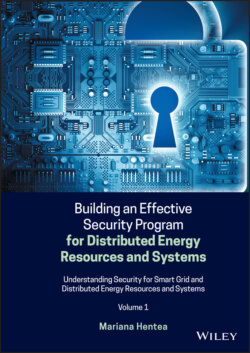Читать книгу Building an Effective Security Program for Distributed Energy Resources and Systems - Mariana Hentea - Страница 24
1.2.4.3 WAN
ОглавлениеWAN is deployed and operated within vast area of tens of kilometers and consists of several NANs and local distribution companies (LDCs). LDC is a distribution company that maintains the portion of the utility supply grid that is closest to the residential and small commercial consumer. Moreover, the communication of all Smart Grid’s components, including operator control center, main and renewable energy generation, transmission and distribution, is based on WAN. The WAN has very high transmission data rate up to few Gbps. The WAN can be implemented by Ethernet networks, WiMAX, 3G/LTE, and microwave transmission.
Several published research works are focused on Smart Grid communication infrastructure. This work [Chen 2010] presents a communication infrastructure for Smart Grid based on hierarchical electricity distribution. The power system is typically hierarchical and is divided by functional areas depending on the voltage levels. These levels are the transmission network, the high/middle voltage (HV/MV) substations, the MV distribution network, the MV/LV transformer substations, and the low voltage (LV) network.
This work [Yan 2013] approaches Smart Grid communication infrastructure as a system of systems that is extremely complex. As a consequence, modeling, analysis, and design of a suitable communication infrastructure should meet many new challenges. The models to be used must be capable of accounting for uncertainty as a way to simulate emerging behavior. The control system and particularly communication infrastructure must be designed to manage uncertainty and inconsistencies to be resilient or gracefully degrade when necessary. Finally, the performance metric must be adjusted to the new nature of the power system.
The authors of this work [Yan 2013] explore the challenges for Smart Grid system. Since a Smart Grid system may have over millions of consumers and devices, the demand for reliability and security is extremely critical. Through a communication infrastructure, a Smart Grid can improve power reliability and quality to eliminate electricity blackout. Security is a challenging issue since the ongoing Smart Grid systems are facing increasing vulnerabilities as more and more automation, remote monitoring, controlling, and supervision entities are interconnected. The authors argue that a Smart Grid built on the technologies of sensing, communications, and control technologies offer a very promising future for utilities and users. Summarizing the basic requirements of communication infrastructure in Smart Grid paradigm highlights that efficiency, reliability, and security of interconnected devices and systems are critical to enabling Smart Grid communications.
However, sensors can be used in many Smart Grid applications, but their limitations and challenges need to be accounted. For example, sensors for substation condition motoring can be simple or complex, depending on the parameters to be monitored and monitoring techniques for transformer condition monitoring. Sensors are also used on other power equipment such as surge arresters, circuit breakers, instrument transformers, capacitor banks, station batteries, etc. While there are benefits of using the sensor technology, there should be a strategy how to use in a secure way.
There should be an understanding of the benefits and challenges of several technologies that are currently available to be used for Smart Grid implementation. This work [Baimel 2016] provides a brief introduction on the advantages and disadvantages of some common technologies used for Smart Grid communication infrastructure:
Although ZigBee technology offers advantages (e.g. low cost, relatively small bandwidth use), its operation in unlicensed frequency of 868 MHz and 2.4 GHz could have interference with other Wi‐Fi, Bluetooth, and microwave signals.
Advantages of the cellular networks include already existing infrastructure with wide area of deployment, high rates of data transfer, and available security algorithms that are already implemented in the cellular communications, but major disadvantage is sharing cellular networks with other users, so they are not fully dedicated to the Smart Grid communications; their use be a serious problem in case of emergency state of the grid.
Advantages of the PLC are already established as widespread infrastructure that reduces installation costs; disadvantages are presence of higher harmonics in the power lines that interfere with communication signals and limited frequency of communication.
Therefore, with each technology used for Smart Grid implementation, there should be more vigilance in early identification of the security challenges of that technology in the environment to be used such that a decision for risk mitigation in terms of acceptance, transfer, or avoidance must be made before and during the design phase. As highlighted in [Baimel 2016], the success of the Smart Grid depends directly on reliable, robust, and secure communication system with high data rate capability.
